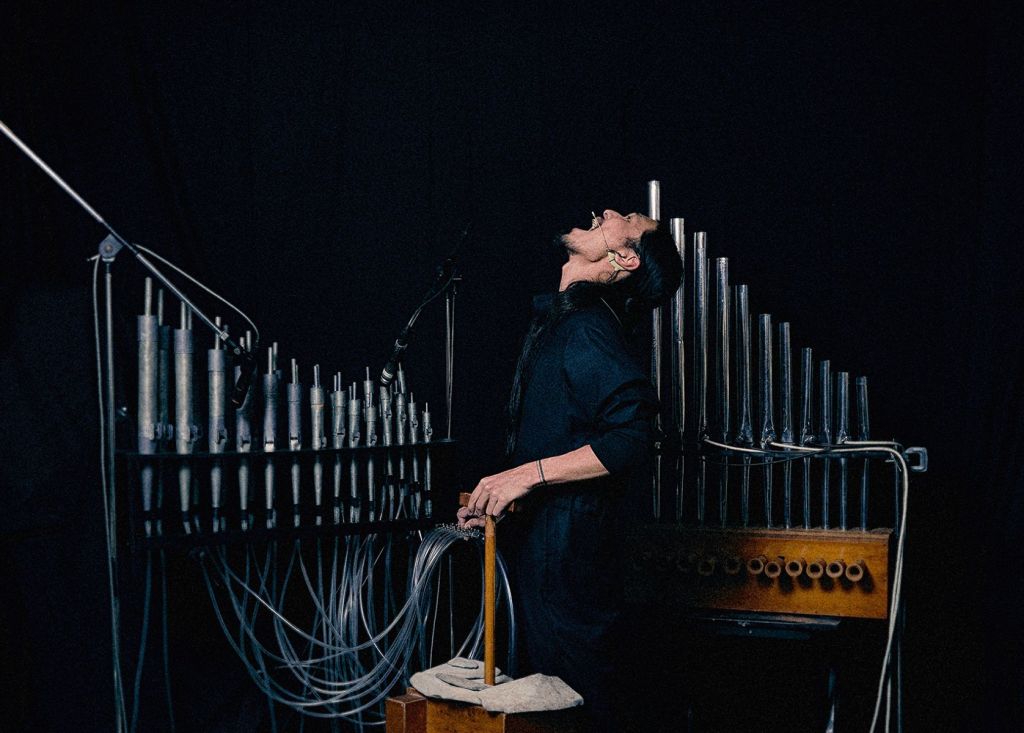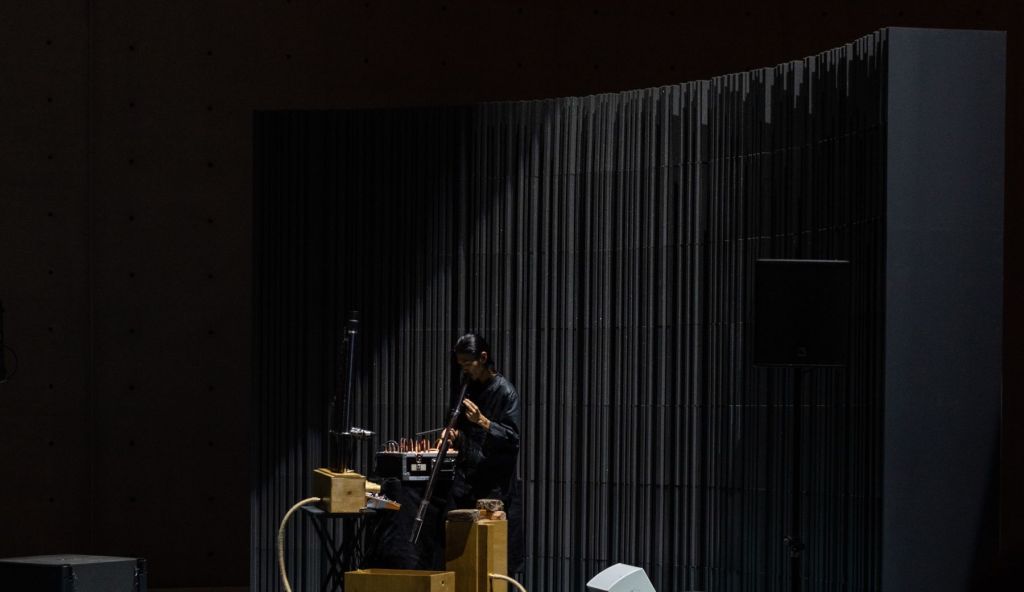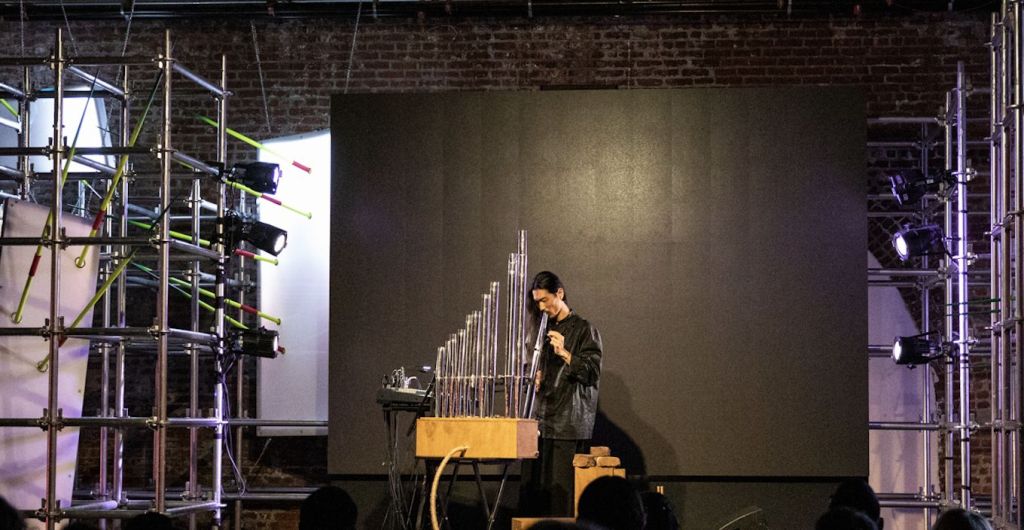Interview by Luca Nasciuti

FUJI|||||||||||TA is a Japanese sound artist whose work is focused on the exploration of sound on the limit of what is audible; take his 2017 installation Cell, for instance, which amplifies the sound of black soldier fly maggots buried in the dirt.
Sound and music in FUJI|||||||||||TA’s performances and records are approached as landscapes with the intention of uncovering different phenomena. This practice is the result of an interest in listening as a primary method for composition. Fujita immerses himself in the sonic environment around him. Therefore, the music he composes reflects the behaviour of sound and listening strategies we actively and passively engage with in everyday life.
The artist created a pipe organ in 2009 that consists of 11 pipes but no keyboard. The instrument is a product of his imagination and does not rely on prior knowledge of instrument making. The organ is a reflection of the composer’s idea of landscape, and it is inspired by the Japanese music form GAGAKU. After releasing hibinari in 2010, FUJI|||||||||||TA developed his music practice by combining the organ with his own voice to fully explore the tonal and textural sonic qualities the two products have together. Since 2006 he has had many solo performances and collaborative works with musicians, including ∈Y∋ (Boredoms), Akio Suzuki, Keiji Haino, Koichi Makigami, Fuyuki Yamakawa and Yukio Suzuki.
FUJI|||||||||||TA’s work and aesthetic are constantly developing, and he now includes synthesised as well as environmental sound in his performances. The organ is therefore augmented as all sonic elements collide and intertwine in the production of complex sonic environments where textures interact and shift just like a living organism. This is the result of his latest release, ‘NOISEEM’, a major new work consisting of recordings of live performances in London and Tokyo. ‘NOISEEM’ is the product of half a decade of work with amplified water. FUJI|||||||||||TA created a series of water tanks with their pumps and amplification controlled by the performer. Just like the organ and his voice, water becomes a new musical instrument.
The release is a testament to FUJI|||||||||||TA’s intention to develop, change and morph his practice and sound while exploring embodied performance and instrument augmentation as spatiality as opposed to mechanical performativity. Body, objects and elements fuse in the production of space, an experience that affects the listener on a physical level. The material produced is a sonic whole that envelops the listener in a newly constructed environment.
This is an environment that can be described as mass, energy and space moving in, towards and around a listening subject that is the centre of the experience, a wholistic approach to sound practice, for it includes all senses. In fact, FUJI|||||||||||TA mentions sound as a phenomenon where there is no distinction between aural and visual; he approaches everything as a phenomenon and describes his practice as close observation and experimentation.


Your work encompasses sound and multimedia. It features instruments, objects, field recordings, the voice, and the body. Could you define your relationship with sound? How do you approach sound, listening and production?
I view everything phenomenally. There is no distinction between aural and visual; I see everything as a phenomenon. For example, suppose you are standing idly in your garden and lightning strikes in front of you. Of course, you’d be freaked out, but would it be by the sound, the light, or the vibrations? If you think about it, it would probably be all of them as a set. Everything is a set and one phenomenon. And my approach is to observe it closely. So I don’t actually consider myself dealing with a variety of media; I’m just trying to experiment to find something worthwhile to observe.
You are active not only as a musician but also as a sound artist and film composer. Is there a common thread in your work? How do you approach the creative agency in a collaboration?
As I mentioned earlier, the differences in media are not that important to me. What is important is whether something is worth observing and whether I can feel something phenomenal there. It is really important to be truly interested in the collaborator. Of course, both parties need to compromise, but it is more interesting if each party has a strong sense of their own values and creative identity. It is exciting to have another set of values come into the production process, and sometimes I get more pleasure and discovery than when I work solo. However, my expression is fundamentally too sensitive, so I cannot collaborate with everyone, and in fact, I limit my collaborative work to a very limited number of people.
Regarding your performance with the Intonarumori – the Futurists’ sound machine, how do you place your practice locally, in Japan, and abroad? How do you navigate historical practices, narratives, local culture and knowledge, and intersectionality?
I prefer not to position my activities; I have very personal perspectives, so I don’t think I have a very good idea of where I stand in society. When I created the Intonarumori, my primary motivation was not context but simply to add another element to my organ. But I don’t think that makes it irrelevant to the context. In fact, I sympathize with the attempts of Luigi Russolo, Erik Satie, and other artists who were considered heretics at that time, and I think that is why I was able to try to collaborate with Intonarumori. I think I may have been more concerned with the fact that attitudes as artists are closer than the historical context.
Your practice is centred on composition, musicianship, performance, and instrument building. There is a breadth of musicians and makers concerned with augmenting existing instruments and creating new ones. Can you describe your relationship with this practice?
This is probably my most misunderstood point, but I actually have very little interest in making instruments. I often build instruments, but my main motivation has always been to play and discover and experience new sounds. In other words, I believe that experimenting to find new sounds naturally leads to the creation of musical instruments.
Could you describe the pipe organ you have created? What are its parts? How do they respond to the body/performance as well as the software and hardware you work with?
I built the organ at a particularly difficult financial time, so making the process as affordable as possible was important. The concept took shape using only cheap material that I purchased at the nearest hardware store. I didn’t have a blueprint or plan; I just created it from my imagination. As for the pipes, I looked up the structure of organ pipes on the internet and made pipes with a similar structure by bending stainless steel sheets by hand.
One of the strengths of self-made instruments is that they easily become a part of your body. Just like breathing doesn’t require a conscious action, the organ can be operated like my breathing. When I perform, the organ is on the same level as my voice, while at the same time, it feels like the breath of another self from a larger perspective. When that perspective is extended to the entire space, the entire space becomes an organ.
Underwater sound dominates your latest release, NOISEEM, and it finds a way to dialogue and sings with a range of compositional material from noise to pitch and rhythm. There is a strong mimetic intention whereby animal calls, voices, and percussions can be evoked in the release. How does the relationship between electronic/electroacoustic & live sound create such a sense of narrative?
This also speaks to my point about “phenomena”. My definition of the word “phenomenal” is a bit vague, but anyway, there is a state of phenomenal behaviour, whether in electronic or live sound. If we can successfully create such a state, a story will naturally emerge, and the work will be able to be seen in various ways depending on how it is observed. I would add that I like electronically generated sounds to behave very much like living things and also live sounds to behave very much like electronic sounds.
Your performances drift in and out of the full spectrum of noise – both as a music genre as well as an affective listening experience. What is your relationship with noise music, noise as pollution, as well as the soundscape employed in your practice?
There are several ways of defining noise. For example, if you go to a cafe and want to listen to a refrigerator there that has a nice faint overtone, the pop song playing in the store’s BGM is noise. In other words, once focused, any sound is no longer noise. Of course, there are exceptions. Perhaps my basic attitude is similar to this; in music and in everyday life, I love sound so much that I am always in a state of focus. So it is not noise in the first place. That is the basic principle. However, conversely, when I am in a state where I cannot focus on anything, everything becomes noise. So when facing noise or soundscapes, or I guess the same for anything, the state of one’s input is most important.
NOISEEM feels separate from noise. The bodily, violent experience of much of noise music performances seems to lead the way to a more complex balancing of energy formation. Masses of sonic material feel in continuous flux, and they blur boundaries of real/imaginary spaces, sonic/visual experiences, affect and daydreaming. How would you describe your aesthetics today, and how do you see it developing in the future?
My aesthetic is a little too simple now, but I would like to move toward a more complex one in the future. There are things that I cannot observe well, no matter how many times I try. It depends on the breadth of what I can observe. Sometimes something simple can be impossible to capture. But as phenomena become more expansive, I can focus on more complex things and different perspectives.
What’s your chief enemy of creativity?
With so much information and the influence of social media, and with things changing so quickly, we tend to unknowingly make judgments based on the judgment of those around us rather than our own. The most important thing for creativity is having a set of values and personal awareness.
My priority, above all, is to nurture and cherish my own values as much as possible. To achieve this, it’s a priority to be sympathetic to those around you. That is, of course, not an easy task. I have a lot of respect for artists who express their values and awareness in their work. It is unique, and I hope I can achieve that.
You couldn’t live without…
The Unknown.






